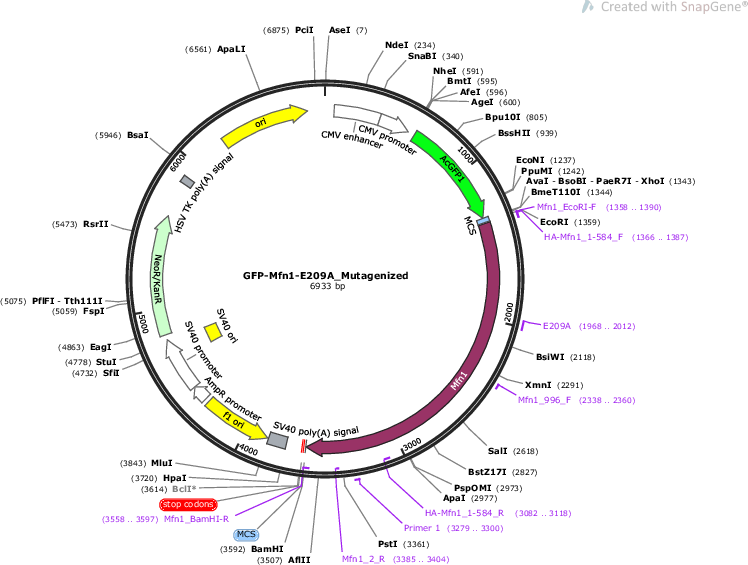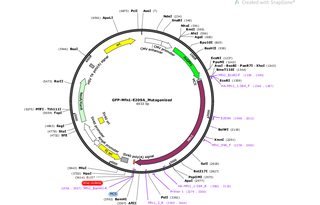GFP-Mfn1-E209A
(Plasmid
#141155)
-
PurposeMammalian expression and labeling of mutant mitofusin 1 (E209A) deficient in GTP hydrolysis
-
Depositing Lab
-
Sequence Information
Ordering
| Item | Catalog # | Description | Quantity | Price (USD) | |
|---|---|---|---|---|---|
| Plasmid | 141155 | Standard format: Plasmid sent in bacteria as agar stab | 1 | $85 | |
Backbone
-
Vector backbonepAcGFP-C1
-
Backbone manufacturerClontech
- Backbone size w/o insert (bp) 4707
- Total vector size (bp) 6933
-
Vector typeMammalian Expression
-
Selectable markersNeomycin (select with G418)
Growth in Bacteria
-
Bacterial Resistance(s)Kanamycin, 50 μg/mL
-
Growth Temperature37°C
-
Growth Strain(s)DH5alpha
-
Copy numberHigh Copy
Gene/Insert
-
Gene/Insert nameMFN 1
-
Alt namemitofusin 1
-
SpeciesH. sapiens (human)
-
Mutationchanged Glutamic acid at position 209 to Alanine (E209A)
-
GenBank IDNM_033540
-
Entrez GeneMFN1 (a.k.a. hfzo1, hfzo2)
- Promoter CMV
-
Tag
/ Fusion Protein
- AcGFP (N terminal on backbone)
Cloning Information
- Cloning method Restriction Enzyme
- 5′ cloning site EcoRI (not destroyed)
- 3′ cloning site BamHI (not destroyed)
- 5′ sequencing primer CMV Forward
- 3′ sequencing primer pFastBac Reverse (Common Sequencing Primers)
Resource Information
-
Supplemental Documents
Terms and Licenses
-
Academic/Nonprofit Terms
-
Industry Terms
- Not Available to Industry
Trademarks:
- Zeocin® is an InvivoGen trademark.
These plasmids were created by your colleagues. Please acknowledge the Principal Investigator, cite the article in which the plasmids were described, and include Addgene in the Materials and Methods of your future publications.
-
For your Materials & Methods section:
GFP-Mfn1-E209A was a gift from Gia Voeltz (Addgene plasmid # 141155 ; http://n2t.net/addgene:141155 ; RRID:Addgene_141155) -
For your References section:
Fission and fusion machineries converge at ER contact sites to regulate mitochondrial morphology. Abrisch RG, Gumbin SC, Wisniewski BT, Lackner LL, Voeltz GK. J Cell Biol. 2020 Apr 6;219(4). pii: 133843. doi: 10.1083/jcb.201911122. 10.1083/jcb.201911122 PubMed 32328629





